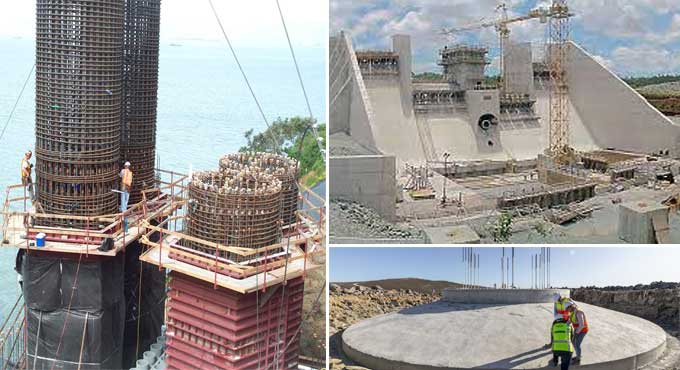
Unveiling the Importance of Mass Concrete in Construction: Properties, Advantages, Challenges, and Applications

Mass concrete represents an engineered solution for the construction of sizeable structures. Its distinctive formulation and characteristics are devised to combat the heat generation and subsequent thermal expansion inherent in voluminous structural elements.
This specialized concrete variety is a cornerstone of the construction world, ensuring stability and durability in monumental projects.
Properties of Mass Concrete:
1. Thermal Mastery: Mass concrete's unparalleled thermal stability stems from meticulous mix design adjustments that minimize temperature differentials. This safeguards against thermal cracking, even when subjected to extreme temperature fluctuations.
2. Heightened Density: Unlike conventional concrete, mass concrete boasts an elevated mass density ranging from 2400 kg/m³ to 2800 kg/m³ (150 lb/ft³ to 175 lb/ft³) or higher. This robust density endows it with substantial load-bearing capacity and exceptional strength.
3. Cement Content Calculations: To curtail excessive heat generation, mass concrete formulations incorporate lower cement content. This strategic reduction regulates hydration kinetics, resulting in controlled internal temperature elevation.
4. Gradual Heat Evolution: Mass concrete's unique attribute is its gradual heat generation during curing. This gradual process ensures uniform temperature distribution, mitigating the risk of thermal stresses and cracks.
Advantages of Mass Concrete:
1. Enduring Durability: Mass concrete's inherent thermal stability significantly reduces the chances of cracks due to temperature variations, ensuring a prolonged lifespan and unyielding durability.
2. Structural Fortitude: In scenarios demanding considerable load-bearing capacity, such as dams, bridges, and skyscrapers, mass concrete imparts robust structural integrity, enhancing overall stability.
3. Reduced Maintenance: The longevity of mass concrete structures translates to diminished maintenance needs over their lifecycle, resulting in substantial cost savings.
4. Thermal Regulation Expertise: Mass concrete's heat-absorbing properties enable strategic temperature regulation within structures, contributing to enhanced energy efficiency.
Disadvantages of Mass Concrete:
1. Leisurely Construction Timeline: The gradual heat generation and extended curing periods associated with mass concrete projects lead to longer construction timelines compared to standard concrete projects.
2. Temperature Control Challenges: Maintaining precise temperature control during curing poses challenges, as even slight temperature fluctuations can impact the final quality and structural stability.
3. Lingering Cracking Concerns: Despite its design to minimize cracking, suboptimal mix design or inadequate curing practices can still result in cracking, compromising structural integrity.
Challenges of Mass Concrete:
1. Extended Timelines: Due to slow heat generation and extended curing periods, construction timelines for mass concrete projects can be longer.
2. Explanation: The gradual curing process of mass concrete takes more time compared to standard concrete, which can lead to extended construction schedules, potentially affecting project timelines.
3. Temperature Control Challenges: Maintaining precise temperature control during curing poses challenges, affecting final quality and structural stability.
4. Explanation: Ensuring uniform and controlled curing temperatures throughout the mass concrete can be challenging, and any deviations can impact the final quality and structural stability of the concrete.
5. Cracking Concerns: Despite efforts to minimize cracking, inadequate mix design or curing can compromise structural integrity.
6. Explanation: While mass concrete is designed to minimize cracking, factors like improper mix design or curing practices can still lead to the formation of cracks, potentially undermining the structural integrity of the construction.
Mass Density of Concrete:
Mass concrete's density varies based on the specific mix composition and additive utilization. While standard concrete registers a density around 2400 kg/m³ (150 lb/ft³), mass concrete often falls within the range of 2400 kg/m³ to 2800 kg/m³ (150 lb/ft³ to 175 lb/ft³) or potentially higher.
Applications in Construction:
1. Dominating Dams and Hydroelectric Power: Mass concrete is a staple in dam construction, offering stability against water pressure and serving as a foundation for hydroelectric power plants.
2. Pillars of Strength in Tall Structures: For skyscrapers and towers, mass concrete provides the foundational strength to counteract the forces exerted by tall structures.
3. Vital Role in Nuclear Power: Its heat absorption and distribution qualities make mass concrete indispensable in housing structures for nuclear reactors, contributing to temperature regulation and safety.
4. Foundations for Resilient Bridges: Mass concrete's durability and load-bearing prowess render it ideal for constructing bridge piers and abutments, ensuring longevity and stability.
Insights and Guidelines for Working with Mass Concrete:
1. Crafting a Precise Mix Design: Achieving optimal thermal properties and strength requires meticulous mix design adjustments that cater to the project's specific needs.
2. Vigilant Temperature Monitoring: Continuous temperature monitoring throughout the curing phase is essential to prevent the emergence of cracks and ensure structural integrity.
3. Embracing Gradual Curing: Allowing ample time for curing is crucial to maintaining controlled internal temperature elevation, and preventing thermal stress-related issues.
4. Formwork Insulation: Insulating formwork aids in sustaining consistent temperatures during the curing process, contributing to uniform concrete quality.
5. Seeking Expert Consultation: Given the intricacies of mass concrete, consulting experienced engineers and concrete specialists are crucial to navigating potential challenges effectively..
To learn more, watch the following video tutorial.
Video Source: Structural Guide
Final Thoughts
In summation, mass concrete emerges as a specialized material catering to the demands of massive structures. Its tailored properties render it invaluable for projects prioritizing durability, stability, and temperature control.
Massive concrete structures are the result of human innovation and enable awe-inspiring architecture. Its properties, benefits, and challenges intersect to create a material that defies the limits of construction. Building for strength, stability, and the future requires mass concrete, which continues to push the boundaries of engineering and architecture.
While grappling with challenges is inevitable, the benefits it bestows in terms of resilience and structural soundness make it an optimal choice across a diverse range of construction applications. This remarkable construction material stands as a testament to human ingenuity, enabling the realization of monumental feats in engineering and architecture.


